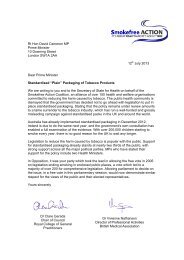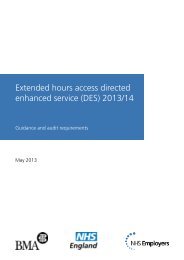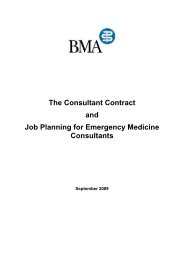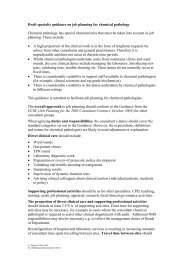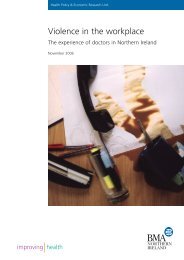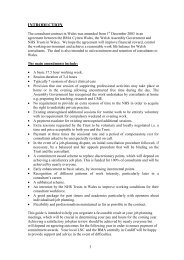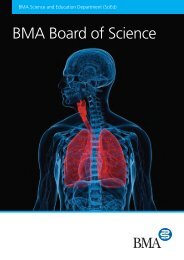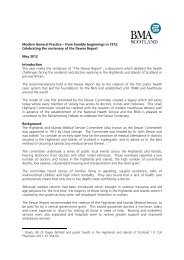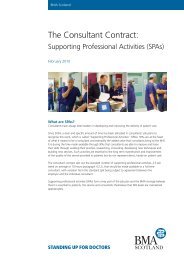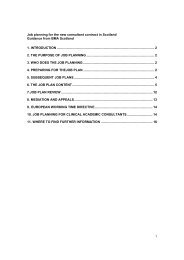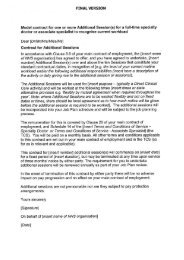Patient participation directed enhanced service 2013-2014 ... - BMA
Patient participation directed enhanced service 2013-2014 ... - BMA
Patient participation directed enhanced service 2013-2014 ... - BMA
Create successful ePaper yourself
Turn your PDF publications into a flip-book with our unique Google optimized e-Paper software.
<strong>Patient</strong> <strong>participation</strong> <strong>directed</strong><br />
<strong>enhanced</strong> <strong>service</strong> (DES) for GMS<br />
contract <strong>2013</strong>/14<br />
Guidance and audit requirements<br />
May <strong>2013</strong>
Contents<br />
Section 1 <strong>Patient</strong> <strong>participation</strong> DES <strong>2013</strong>/14: guidance and<br />
audit requirements<br />
Introduction<br />
Key objectives<br />
Section 2 Implementing the patient <strong>participation</strong> DES under<br />
the DES Directions<br />
Component 1: Develop a structure that gains the views of<br />
patients and enables the practice to obtain feedback from the<br />
practice population<br />
Component 2: Agree areas of priority with the patient reference<br />
group (PRG)<br />
Component 3: Collate patient views through the use of a survey 8<br />
Component 4: Provide PRG with opportunity to discuss survey<br />
findings and reach agreement with the PRG on changes to<br />
<strong>service</strong>s<br />
Component 5: Agree action plan with the PRG and seek PRG<br />
agreement to implementing changes<br />
Component 6: Publicise actions to be taken and subsequent<br />
achievement<br />
Frequency and sample size 11<br />
Validation and payment 12<br />
Section 3 Annex: Creating a virtual PRG - Getting started<br />
guide<br />
1. Common patient questions and answers 15<br />
2. Sample contact form 15<br />
3. Developing your survey 16<br />
4. Script for patient group members 18<br />
5. Script for staff in practices with a PRG 18<br />
6. Script for staff in practices without a PRG 19<br />
7. Suggested wording for an LED display 19<br />
8. Suggested leaflet/flyer content 19<br />
9. Suggested poster content 20<br />
Section 4 Queries process 21<br />
3<br />
3<br />
3<br />
5<br />
5<br />
7<br />
9<br />
9<br />
10<br />
14<br />
2
<strong>Patient</strong> <strong>participation</strong> <strong>directed</strong> <strong>enhanced</strong> <strong>service</strong> (DES) for GMS contract <strong>2013</strong>/14<br />
Section 1. <strong>Patient</strong> <strong>participation</strong> DES<br />
<strong>2013</strong>/14: guidance and audit<br />
requirements<br />
Introduction<br />
This document provides NHS England area teams and practices with information to<br />
support the patient <strong>participation</strong> DES. This <strong>service</strong> has been commissioned for a further<br />
year effective from 1 April <strong>2013</strong> until 31 March <strong>2014</strong>. The DES applies to England only.<br />
This guidance should be read in conjunction with the Primary Medical Services (Directed<br />
Enhanced Services) (England) Directions <strong>2013</strong> (the DES Directions) 1 and the Statement of<br />
Financial Entitlements (SFE) 2 .<br />
Indicators relating to access are no longer included in the Quality and Outcomes<br />
Framework (QOF). However, it is expected that the quality of access currently provided<br />
by contractors in respect of obtaining an appointment within two working days and the<br />
ability to book ahead should be maintained unless there is clear evidence to support a<br />
change.<br />
Key objectives<br />
The purpose of the patient <strong>participation</strong> DES is to ensure that patients are involved in<br />
decisions about the range and quality of <strong>service</strong>s provided and over time, commissioned<br />
by their practice. It aims to encourage and reward practices for routinely asking and<br />
acting on the views of their patients. This includes the patients being involved in<br />
decisions that lead to changes to the <strong>service</strong>s their practice provides or commissions,<br />
either directly or in its capacity as gatekeeper to other <strong>service</strong>s. The DES aims to<br />
promote the proactive engagement of patients through the use of effective <strong>Patient</strong><br />
Reference Groups (PRGs) and to seek views from practice patients through the use of a<br />
local practice survey. The outcomes of the engagement and the views of patients are to<br />
be published on the practice's website.<br />
One aspect that practices may wish to focus on is ensuring convenient access to the<br />
practice and also from the practice to other <strong>service</strong>s in its role as coordinator of care,<br />
facilitating access to other health and social care providers.<br />
1<br />
Department of Health (DH).DES Directions.<br />
https://www.gov.uk/government/uploads/system/uploads/attachment_data/file/127322/Primary-Medical-<br />
Services-Directed-Enhanced-Services-Directions-<strong>2013</strong>.pdf.pdf<br />
2<br />
DH. SFE. https://www.gov.uk/government/uploads/system/uploads/attachment_data/file/127320/GMS-<br />
Statement-of-Financial-Entitlements-<strong>2013</strong>.pdf.pdf<br />
3
<strong>Patient</strong> <strong>participation</strong> <strong>directed</strong> <strong>enhanced</strong> <strong>service</strong> (DES) for GMS contract <strong>2013</strong>/14<br />
Access has many dimensions; the relative importance of these will vary according to the<br />
specific needs of the registered population. These dimensions include:<br />
lists being open to all<br />
hours of opening with the ability to be seen urgently when clinically necessary, as well as<br />
the ability to book ahead<br />
continuity of care<br />
range of skills available - access to different professionals<br />
a choice of modes of contact which currently includes face-to-face, telephone and<br />
electronic contact, but can be developed further as technology allows<br />
geographical access, enabling care as close to home as possible.<br />
Access must be flexible enough to meet the varying needs of individuals and requires<br />
sufficient capacity to meet the population's needs. Details of access arrangements<br />
(including opening hours) should be made widely available to the patient population to<br />
enable patients to exercise choice.<br />
Qualifying practices will establish a <strong>Patient</strong> Reference Group (PRG). This may be an<br />
existing formal patient <strong>participation</strong> group or a similar group that is representative of<br />
the practice population, which would feed in its views alongside the findings from the<br />
surveys and agree with the practice priority areas for possible change. This would result<br />
in an action plan to be agreed between the practice and the PRG.<br />
Practices taking part in this DES will also carry out a properly constituted survey of a<br />
sample of the practice's patients looking at a broad range of areas which could include<br />
convenience of access (opening times, ability to book ahead, ability to be seen quickly,<br />
telephone answering), patients' experience of the treatment and <strong>service</strong> they receive,<br />
the physical environment in the practice and other issues specific to individual practices.<br />
4
<strong>Patient</strong> <strong>participation</strong> <strong>directed</strong> <strong>enhanced</strong> <strong>service</strong> (DES) for GMS contract <strong>2013</strong>/14<br />
Section 2. Implementing the patient<br />
<strong>participation</strong> DES under the DES<br />
Directions<br />
There are a number of key components to this DES:<br />
Component 1: Develop a structure that gains the views of patients and enables the practice<br />
to obtain feedback from the practice population, e.g. a PRG<br />
Component 2: Agree areas of priority with the PRG<br />
Component 3: Collate patient views through the use of a survey<br />
Component 4: Provide PRG with opportunity to discuss survey findings and reach<br />
agreement with the PRG on changes to <strong>service</strong>s<br />
Component 5: Agree action plan with the PRG and seek PRG agreement to implementing<br />
changes<br />
Component 6: Publicise actions to be taken and subsequent achievement<br />
More details on these components are set out in this section of the guidance.<br />
Component 1: Develop a PRG<br />
Where a practice is engaging in this DES for the first time in <strong>2013</strong>/14, then the practice<br />
must develop a properly constituted structure that both reflects and gains the views of<br />
its registered patients and enables the practice to obtain feedback from a cross section<br />
of the practice population which is as representative as possible. Practices that have<br />
previously engaged in this DES will not need to recreate a new structure (or PRG), but<br />
may wish to review whether the group remains representative of the practice<br />
population.<br />
Traditionally, practices have developed a PRG through volunteers and regular meetings.<br />
Some practices have developed a virtual PRG, an email community they consult on a<br />
regular basis but which does not have regular face-to-face meetings. The practice<br />
should develop its PRG in the most appropriate way to effectively reach the broadest<br />
cross section of its patient population. This may be a virtual or a face-to-face group or a<br />
combination of the two.<br />
Whichever approach is adopted by the practice, there should be a structure or process<br />
in place to enable regular engagement with a representative sample of the practice<br />
population. Using a strict definition, no PRG will ever be truly representative. Many<br />
localities have incredibly diverse patient populations and all have patients of different<br />
ages and with a wide variety of health and social care needs. Practices participating in<br />
this DES should strive to obtain feedback from a cross section of the practice<br />
population. Practices should be able to outline the steps they have taken to do this and<br />
demonstrate they have made an effort to engage with any underrepresented groups.<br />
5
<strong>Patient</strong> <strong>participation</strong> <strong>directed</strong> <strong>enhanced</strong> <strong>service</strong> (DES) for GMS contract <strong>2013</strong>/14<br />
To do this, the practice needs to have an understanding of its practice profile. This<br />
understanding should take in to account more than just age and sex i.e. this could<br />
include social factors such as working patterns of patients, levels of unemployment in<br />
the area, number of carers, black and minority ethnic groups. Local HealthWatch 3 and<br />
voluntary organisations may be able to support practices to engage with marginalised<br />
or vulnerable groups, such as elderly patients or patients with learning disabilities.<br />
Where a practice has been unable to encourage patient <strong>participation</strong> by a certain<br />
patient group or groups, it must demonstrate what steps have been taken to try and<br />
engage that group.<br />
The practice will only qualify for any payment under this DES if it is able to clearly<br />
demonstrate that it has established a PRG comprising only registered patients and used<br />
its best endeavours to ensure that the PRG is representative of its registered patient<br />
population.<br />
There are steps that practices can take to ensure patient groups are as representative as<br />
possible. The starting point is to use the age and sex make up of their registered<br />
population. Practices should be recording ethnicity routinely in order to be able to<br />
demonstrate that they meet the health needs of their registered population. It is<br />
important that the ethnic make up of the practice is reflected in the representative<br />
group, as much as possible. The practice team will also have local knowledge of specific<br />
care groups that the practice caters for, for instance it may look after a number of<br />
nursing homes, or a learning disabled community, or it may have a high number of<br />
drug users. The practice should try to ensure that such specific care groups are reflected<br />
in the PRG wherever possible. Practices should set up a PRG of a reasonable size which<br />
is representative of the practice population.<br />
Practices should particularly ensure that they comply with the Equality Act 2010 4 when<br />
developing a PRG. Information on compliance can be found on the Equality and Human<br />
Rights Commission website 5 , in the Government Equalities Office guide 6 and on the<br />
Advisory, Conciliation and Arbitration <strong>service</strong> (ACAS) website 7 .<br />
To engage patients, practices may find it useful to learn from the work the National<br />
Association of <strong>Patient</strong> Participation (NAPP) has done in developing PRGs. Best practice<br />
case studies and other resources can be found on the NAPP website 8 . There is also a<br />
recent study available to registered practice managers on the Practice Management<br />
Network website 9 .<br />
3<br />
Local Government Association. Local and National HealthWatch.<br />
http://www.local.gov.uk/web/guest/health/-/journal_content/56/10171/3511523/ARTICLE-TEMPLATE<br />
4<br />
Equality Act 2010. http://www.legislation.gov.uk/ukpga/2010/15/contents<br />
5<br />
Equality and Human Rights Commission. www.equalityhumanrights.com/advice-and-guidance/newequality-act-guidance<br />
6<br />
Government Equalities Office guide.<br />
www.equalities.gov.uk/staimm6geo/pdf/401727_Geo_EqualityLaw_PublicSector_acc.pdf<br />
7<br />
ACAS. www.acas.org.uk<br />
8<br />
NAPP. http://www.napp.org.uk/des2.html<br />
9<br />
Practice Management Network. www.practicemanagement.org.uk/Community-Voices-ReportandGuide<br />
6
<strong>Patient</strong> <strong>participation</strong> <strong>directed</strong> <strong>enhanced</strong> <strong>service</strong> (DES) for GMS contract <strong>2013</strong>/14<br />
Whilst advertising within the practice premises and in the practice patient leaflet will<br />
help, inviting patients personally to join a group (virtual or otherwise) has been shown<br />
to be very effective. Inviting new patients at the point of registration as well as at<br />
routine practice visits also helps to reach those people who attend infrequently. This can<br />
be done either at reception or at the end of the consultation by simply handing a leaflet<br />
to patients. For more information and tools on establishing a PRG see the 'Getting<br />
started guide' at the Annex.<br />
Practices who previously participated in the patient <strong>participation</strong> DES and continue to<br />
participate will not be eligible to receive a payment in respect of component 1. Instead,<br />
their payment for components two to six will be weighted differently.<br />
Component 2: Agree areas of priority with the PRG<br />
The PRG and the practice will shape the ideas covered by the local practice survey.<br />
The areas covered in the local practice survey will, therefore, be agreed jointly based on<br />
key inputs, including the identification of:<br />
patients' priorities and issues<br />
practice priorities and issues including themes from complaints<br />
planned practice changes<br />
Care Quality Commission (CQC) related issues<br />
National GP patient survey issues.<br />
It may be that a standard way or proforma of asking patients about their priorities is<br />
developed and agreed between the practice and the PRG and the words can be<br />
amended to suit the local circumstances of the practice):<br />
We are planning our next annual survey and to ensure that we ask the right questions,<br />
we would like to know what you think our key priorities should be when it comes to<br />
looking at the <strong>service</strong>s we provide to you and others in the practice.<br />
What do you think are the most important issues on which we should consult our<br />
patients? For example, which of the following do you think we should focus on:<br />
Clinical care<br />
Getting an appointment<br />
Reception issues<br />
Opening times<br />
Parking and so on<br />
7
<strong>Patient</strong> <strong>participation</strong> <strong>directed</strong> <strong>enhanced</strong> <strong>service</strong> (DES) for GMS contract <strong>2013</strong>/14<br />
Component 3: Collate patient views through use of a survey<br />
The practice must undertake a local practice survey at least once a year. The number of<br />
questions asked in the local practice survey will be a matter for the practice and its PRG<br />
to agree. Questions should be based on the priorities identified by the PRG and the<br />
practice.<br />
Questions can be taken from existing validated patient surveys subject to the necessary<br />
copyright permissions, or be developed locally. A list of questions compiled from<br />
existing validated surveys is available on the National Association for <strong>Patient</strong><br />
Participation (NAPP) website 10 . Practices may find it useful to draw on these questions<br />
when creating their survey.<br />
Guidance on conducting effective surveys can be found at:<br />
Survey Monkey. Mart survey design.<br />
http://s3.amazonaws.com/SurveyMonkeyFiles/SmartSurvey.pdf<br />
Creative research systems. Survey design. http://www.surveysystem.com/sdesign.htm<br />
KnowHow NonProfit. How to design and use free syrveys online.<br />
http://www.knowhownonprofit.org/how-to/how-to-design-and-use-free-onlinesurveys<br />
Practices may choose to collate and analyse the results themselves or to outsource this<br />
work.<br />
Historically, the majority of practices have made use of two nationally recognised survey<br />
tools - the General Practice Assessment Questionnaire 11 (GPAQ) and the Improving<br />
Practice Questionnaire 12 (IPQ). However, this DES is not prescriptive in mandating who<br />
general practice might choose to support their local practice survey. Selection of the<br />
provider organisation that could operate and analyse the survey is a decision for the<br />
practice, or the practice may decide to do this itself.<br />
Neither is the DES prescriptive on the methodology used to carry out the survey, the<br />
number of questions or topics covered. The local practice survey questions can be asked<br />
by paper or electronically, in the practice or by mail depending on what is considered<br />
the best way locally to canvas the particular population.<br />
It is the responsibility of the practice to demonstrate to its PRG that the proposed survey<br />
or methodology it chooses as the vehicle for undertaking the local practice survey, is<br />
credible. Criteria for assessing credibility include an assessment by the practice that the<br />
processes used for sampling and analysing are sufficient to provide "the reasonable<br />
person" with confidence that the reported outcomes are valid.<br />
This assessment and other evidence supporting the credibility of the survey process<br />
should be included in the report of the practice results.<br />
10 NAPP. http://www.napp.org.uk/<br />
11 GPAQ . http://www.gpaq.info/<br />
12 IPQ. www.cfepsurveys.co.uk<br />
8
<strong>Patient</strong> <strong>participation</strong> <strong>directed</strong> <strong>enhanced</strong> <strong>service</strong> (DES) for GMS contract <strong>2013</strong>/14<br />
Simple guidance on writing effective and valid questions and support information using<br />
online survey tools is provided in the 'Getting started guide' at the Annex.<br />
When the survey is complete the practice should inform the PRG of its findings.<br />
Component 4: Provide PRG with opportunity to discuss<br />
survey findings and reach agreement with the PRG on<br />
changes to <strong>service</strong>s<br />
Practices should respond to the outputs of the latest local practice survey by providing<br />
the PRG with an opportunity to comment on and discuss the findings of the survey,<br />
along with other relevant information. Other relevant information may include themes<br />
from complaints received by the practice or CQC feedback if and when available.<br />
If the local practice survey points to the desire for significant change in a <strong>service</strong> or<br />
<strong>service</strong>s provided, or the way in which <strong>service</strong>s are delivered, the practice must, before it<br />
makes the change, seek the agreement of its PRG to any proposals it makes. Where a<br />
practice proposes any significant change to a <strong>service</strong> or <strong>service</strong>s they provide to which<br />
the PRG agreement has not been obtained, the practice must obtain the agreement of<br />
NHS England (or other appropriate organisation where such functions may have been<br />
delegated) to its proposals. Significant change would include a change in opening<br />
hours. Changes which impact on contractual arrangements also need to be agreed with<br />
NHS England.<br />
Component 5: Agree action plan with the PRG and seek PRG<br />
agreement to implementing changes<br />
Following the discussions in Component 4, an action plan will be agreed with the PRG.<br />
The practice should then seek the agreement of the PRG in implementing the changes<br />
and where necessary inform NHS England (or other appropriate organisation where<br />
such functions may have been delegated). Components 4 and 5 could take place at the<br />
same meeting, at separate meetings via an email group or a combination of these or<br />
other methods.<br />
9
<strong>Patient</strong> <strong>participation</strong> <strong>directed</strong> <strong>enhanced</strong> <strong>service</strong> (DES) for GMS contract <strong>2013</strong>/14<br />
Component 6: Publicise actions taken - and subsequent<br />
achievement<br />
Practices must publish a Local <strong>Patient</strong> Participation Report on their website (where a<br />
practice does not already have a website, one must be set up). As a minimum this must<br />
include:<br />
A. a description of the profile of the members of the PRG<br />
B. the steps taken by the contractor to ensure that the PRG is representative of its<br />
registered patients and where a category of patients is not represented, the steps<br />
the contractor took in an attempt to engage that category<br />
C. details of the steps taken to determine and reach agreement on the issues which<br />
had priority and were included in the local practice survey<br />
D. the manner in which the contractor sought to obtain the views of its registered<br />
patients<br />
E. details of the steps taken by the contractor to provide an opportunity for the PRG<br />
to discuss the contents of the action plan<br />
F. details of the action plan setting out how the findings or proposals arising out of<br />
the local practice survey can be implemented and if appropriate, reasons why any<br />
such findings or proposals should not be implemented<br />
G. a summary of the evidence including any statistical evidence relating to the findings<br />
or basis of proposals arising out of the local practice survey<br />
H. details of the action which the contractor<br />
and, if relevant, NHS England (or other appropriate organisation where such<br />
functions may have been delegated), intend to take as a consequence of<br />
discussions with the PRG in respect of the results, findings and proposals arising<br />
out of the local practice survey; and<br />
where it has participated in the DES for a year (1 April - 31 March), or any part<br />
thereof, ending 31 March <strong>2013</strong>, has taken on issues and priorities as set out in<br />
the Local <strong>Patient</strong> Participation Report<br />
I. the opening hours of the practice premises and the method of obtaining access to<br />
<strong>service</strong>s throughout the core hours<br />
J. where the contractor has entered into arrangements under an extended hours<br />
access scheme, the times at which individual healthcare professionals are accessible<br />
to registered patients.<br />
A copy of this report must also be supplied to NHS England (or other appropriate<br />
organisation where such functions may have been delegated).<br />
10
<strong>Patient</strong> <strong>participation</strong> <strong>directed</strong> <strong>enhanced</strong> <strong>service</strong> (DES) for GMS contract <strong>2013</strong>/14<br />
practices 13 Information on opening hours and progress on the key actions identified with the PRG,<br />
should be updated as needed in the practice leaflet and on the practice website. The<br />
guidance document Improving access, responding to patients: A 'how to' guide for GP<br />
has a section on 'Why and how to create a website' which practices might<br />
find useful.<br />
Practices may wish to ensure that the following are made aware that the report is<br />
available and where it can be viewed:<br />
the PRG<br />
those who answered the survey<br />
the wider practice population<br />
clinical commissioning group<br />
local HealthWatch (which might facilitate effective working between the LH and the PRG)<br />
CQC - at the time of inspections/registration.<br />
Publication of the results and practice opening times might include:<br />
a visible poster within the waiting room area<br />
NHS Choices website 14<br />
summary results sent electronically to the PRG.<br />
The information on actions taken and subsequent achievement should be directly linked<br />
to the feedback from patients.<br />
e.g. You said........... We did........... The outcome was.........<br />
Where there is an ongoing disagreement with the PRG on proposed actions, this must<br />
be publicly highlighted with the practice's rationale for deviating from the accepted plan.<br />
Frequency and sample size<br />
Practices can either choose to repeat this six-component process for every year that they<br />
participate in the DES with an appropriate sample of their practice population, or<br />
demonstrate that they have undertaken an equivalent ongoing engagement with a<br />
smaller number of patients more frequently. An appropriate sample size should be<br />
discussed and agreed with the PRG and should be methodologically appropriate for the<br />
survey being used. Equivalent ongoing engagement with a smaller number of patients<br />
would also allow the use of real-time feedback - as mentioned in the white paper. For<br />
more information see 'A best practice guide to using real-time patient feedback' 15 .<br />
13 Practice Management Network. Improving access, responding to patients: A 'how to' guide for GP<br />
practices. http://www.practicemanagement.org.uk/265<br />
14 NHS Choices. http://www.nhs.uk/Pages/HomePage.aspx<br />
15 Practice Management Network. A best practice guide to using real-time patient feedback.<br />
www.practicemanagement.org.uk/uploads/best_practice_guide_to_using_realtime_patient_feedback,_final_version_august_2010.pdf<br />
11
Validation and payment<br />
<strong>Patient</strong> <strong>participation</strong> <strong>directed</strong> <strong>enhanced</strong> <strong>service</strong> (DES) for GMS contract <strong>2013</strong>/14<br />
Practices will receive an overall payment of £1.10 per registered patient based on its<br />
achievement of the various components as follows:<br />
Component 1 Establish a PRG comprising only of registered patients and use best<br />
endeavours to ensure PRG is representative<br />
Component 2 Agree with the PRG which issues are a priority and include these in a<br />
local practice survey<br />
Component 3 Carry out the local practice survey and collate and inform the PRG of<br />
the findings<br />
Component 4 Provide the PRG with an opportunity to comment and discuss findings<br />
of the local practice survey. Reach agreement with the PRG of changes<br />
in provision and manner of delivery of <strong>service</strong>s. Where relevant, notify<br />
NHS England of the agreed changes<br />
Component 5 Agree with the PRG an action plan setting out the priorities and<br />
proposals arising out of the local practice survey. Seek PRG agreement<br />
to implement changes and where necessary inform NHS England<br />
Component 6 Publicise the Local <strong>Patient</strong> Participation Report on the practice website<br />
and update the report on subsequent achievement<br />
For practices that had not participated in the patient <strong>participation</strong> DES during 2012/13<br />
Component 1 only £0.22 per registered patient<br />
Components 1 and 2 only £0.44 per registered patient<br />
Components 1, 2 and 3 only £0.66 per registered patient<br />
Components 1, 2, 3 and 4 only £0.88 per registered patient<br />
Components 1, 2, 3, 4 and 5 £1.10 per registered patient<br />
For practices that had participated in the patient <strong>participation</strong> DES during 2012/13<br />
Component 2 only £0.11 per registered patient<br />
Components 2 and 3 only £0.33 per registered patient<br />
Components 2, 3 and 4 only £0.66 per registered patient<br />
Components 2, 3, 4, and 5 only £0.99 per registered patient<br />
Components 2, 3, 4, 5, and 6 £1.10 per registered patient<br />
Payment will be made to the practice by NHS England(or other appropriate organisation<br />
where such functions may have been delegated) and will be based on the content of the<br />
report published by the practice on its website.<br />
The report must have been completed and published on the practice's website by no<br />
later than 31 March <strong>2014</strong>. No payments will be made to a practice under the terms of<br />
this DES if the report is not published on the website by 31 March <strong>2014</strong>.<br />
Posting to the website by or before the 31 March <strong>2014</strong> is the responsibility of the<br />
practice.<br />
12
<strong>Patient</strong> <strong>participation</strong> <strong>directed</strong> <strong>enhanced</strong> <strong>service</strong> (DES) for GMS contract <strong>2013</strong>/14<br />
Payment will be based on the evidence provided in the practice report that each<br />
successive component has been achieved.<br />
Should a practice not complete any component by the 31 March <strong>2014</strong> deadline date<br />
for posting the practice report, it will not receive the payment due for that component.<br />
Payment for the achievement of a component is dependant on the previous<br />
components having been successfully completed, for instance a practice cannot receive<br />
a payment for discussing and agreeing with its PRG and changes the practice proposes<br />
(component 4) if the practice has not collated the views of patients beforehand through<br />
the use of a local survey (component 3).<br />
The patient <strong>participation</strong> DES was introduced in 2011/12, initially for two years and has<br />
now been re-commissioned for <strong>2013</strong>/14.Many of the key stages are annual and assume<br />
an iterative approach being adopted by participating practices in developing the<br />
information being included in the practice report it published on its website. Where a<br />
practice participates for two or more successive years, the subsequent year reports<br />
posted by practices should build upon the previous year's report, demonstrating how<br />
issues raised in the previous year(s) have been addressed.<br />
13
<strong>Patient</strong> <strong>participation</strong> <strong>directed</strong> <strong>enhanced</strong> <strong>service</strong> (DES) for GMS contract <strong>2013</strong>/14<br />
Section 3. Annex: Creating a virtual PRG<br />
- Getting started guide<br />
Introduction<br />
The 'getting started guide' has been developed to support practices in setting up virtual<br />
PRGs, it contains a few simple tools that practices can use at the various stages of<br />
setting up a PRG.<br />
The D H commissioned the development of this guide in consultation with patients,<br />
staff and patient group representatives. It is deliberately simple and 'low-tech' in the<br />
hope that it provides a range of quick and easy ways to create a list of patients willing<br />
to help practices by giving their views. Email is a fast and effective way to carry out<br />
simple surveys to get feedback from patients.<br />
Your practice may or may not already have in place a 'real' PRG which meets face-toface.<br />
If it does, it may be simplest to use the 'real' PRG as the main point of email<br />
contact. If you do not already have a 'real' PRG, creating an email contact list is a good<br />
starting point.<br />
There are a number of online survey tools available which are simple to use and have<br />
clear instructions on how to set up a survey. Once you have finalised your survey<br />
questions it takes just minutes to set up the survey online. Some free survey tools are<br />
set out below:<br />
Survey Monkey. Mart survey design.<br />
http://s3.amazonaws.com/SurveyMonkeyFiles/SmartSurvey.pdf<br />
Kwik surveys. http://kwiksurveys.com/<br />
eSurveys pro. http://www.esurveyspro.com/ www.esurveyspro.com<br />
Smart survey. http://www.smart-survey.co.uk/ www.smart-survey.co.uk<br />
Content of the guide<br />
1. Common patient questions and answers<br />
2. Sample contact form<br />
3. Developing your survey<br />
4. Script for patient group members<br />
5. Script for staff in practices with a PRG<br />
6. Script for staff in practices without a PRG<br />
7. Suggested wording for an LED display<br />
8. Suggested leaflet/flyer content<br />
9. Suggested poster content<br />
14
<strong>Patient</strong> <strong>participation</strong> <strong>directed</strong> <strong>enhanced</strong> <strong>service</strong> (DES) for GMS contract <strong>2013</strong>/14<br />
1. Common patient questions and answers<br />
1.1 Why are you asking patients for their contact details?<br />
We would like to be able to contact patients occasionally to ask them questions<br />
about the practice and how well we are doing to identify areas for improvement.<br />
1.2 Will my doctor see this information?<br />
This information is purely to contact patients to ask them questions about the<br />
practice, how well we are doing and ensure changes that are being made are<br />
patient focused. If your doctor is responsible for making some of the changes in<br />
the practice they might see general feedback from patients.<br />
1.3 Will the questions you ask me be medical or personal?<br />
We will only ask general questions about the practice, such as short<br />
questionnaires.<br />
1.4 Who else will be able to access my contact details?<br />
Your contact details will be kept safely and securely and will only be used for this<br />
purpose and will not be shared with anyone else.<br />
1.5 How often will you contact me?<br />
Not very often... [insert how often you plan to contact patients]<br />
1.6 What is a patient group/patient <strong>participation</strong> group?<br />
This is a group of volunteer patients who are involved in making sure the practice<br />
provides the <strong>service</strong>s its patients need.<br />
1.7 Do I have to leave my contact details?<br />
No, but if you change your mind, please let us know<br />
1.8 What if I no longer wish to be on the contact list or if I leave the practice?<br />
We will ask you to let us know by email if you do not wish to receive further<br />
messages.<br />
2. Sample contact form<br />
If you are happy for us to contact you periodically by email please complete your details<br />
below and hand this form back to reception, a patient group representative, or post in<br />
the 'secure box'.<br />
Name:<br />
Email address:<br />
Postcode:<br />
This additional information will help to make sure we try to speak to a representative<br />
sample of the patients registered at this practice.<br />
Are you? Male Female <br />
15
Age: Group Under 16 17 - 24 <br />
25 - 34 35 - 44 <br />
45 - 54 55 - 64 <br />
65 - 74 75 - 84 <br />
Over 84 <br />
<strong>Patient</strong> <strong>participation</strong> <strong>directed</strong> <strong>enhanced</strong> <strong>service</strong> (DES) for GMS contract <strong>2013</strong>/14<br />
To help us ensure our contact list is representative of our local community please<br />
indicate which if the following ethnic background you would most closely identify with?<br />
White<br />
British Group Irish <br />
Mixed<br />
White & Black Caribbean White & Black African White & Asian <br />
Asian or Asian British<br />
Indian Pakistani Bangladeshi <br />
Black or Black British<br />
Caribbean African <br />
Chinese or other ethnic Group<br />
Chinese Any Other <br />
How would you describe how often you come to the practice?<br />
Regularly <br />
Occasionally <br />
Very rarely <br />
Thank you.<br />
Please note that no medical information or questions will be responded to.<br />
The information you supply us with will be used lawfully, in accordance with the Data<br />
Protection Act 1988. The Data Protection Act 1988 gives you the right to know what<br />
information is held about you, and sets out rules to make sure that this information is<br />
handled properly.<br />
3. Developing your survey<br />
An important goal as a survey author is to construct clear, direct questions and answers<br />
using the language that survey participants will understand. While there are no set rules<br />
on the wording of these survey questions, there are some basic principles that do work<br />
in improving the overall design.<br />
Constructing good questions<br />
1. Be brief - Keep questions short and ask one question at a time.<br />
2. Be objective<br />
a. Avoid leading questions, such as "We have recently upgraded this site's<br />
16
<strong>Patient</strong> <strong>participation</strong> <strong>directed</strong> <strong>enhanced</strong> <strong>service</strong> (DES) for GMS contract <strong>2013</strong>/14<br />
features to become a first-class tool. What are your thoughts on the new site?"<br />
Replace with "What are your thoughts on the upgrades to this site?".<br />
b. Avoid loaded questions.<br />
c. Avoid built-in assumptions about things the respondent may or may not know<br />
about.<br />
3. Be simple<br />
a. Avoid jargon.<br />
b. Avoid using extremes such as "never" "always" and "only".<br />
4. Be specific<br />
a. Avoid asking things that are too general, too complex or undefined.<br />
Types of questions<br />
The question type determines the type of information collected:<br />
1. Open-ended - where respondent has free text to write what they want.<br />
a. Pros: good to use when asking for attitude or feelings, likes and dislikes,<br />
memory recall, opinions.<br />
b. Cons: some respondents don't find it easy and so put "I don't know", it can<br />
take the respondent longer to fill in and can take you longer to analyse.<br />
2. Close-ended - where respondents answer 'yes' or 'no' or from a multiple choice<br />
list.<br />
3. Ranked - Where respondents rank what is most or least important, on a scale from<br />
1-5.<br />
a. 1-5 is thought to be the right number of options (e.g. no more).<br />
b. Generally, you would have two negative, two positive and a neutral, to make<br />
sure it is balanced.<br />
c. If you remove the neutral option you force the respondent to choose either a<br />
negative or positive. There's no fixed rule on whether this is right.<br />
4. Rating - is a popular way of collecting subjective data where you want to measure<br />
the ideas of a respondent (for instance opinions, knowledge and feelings). There<br />
are two types:<br />
a. Create a statement and ask respondents to rate how they feel about it, for<br />
instance "Strongly disagree/Disagree/Neutral" and so on.<br />
b. Provide respondents with a scale, for instance from "Improved" to "Not<br />
improved" and ask them to rate their opinion on this scale.<br />
Encouraging respondents to complete the survey<br />
1. Asking people to participate in advance can boost response numbers.<br />
2. Have an introduction that briefly explains what the survey is about. Within the<br />
introduction you may want to include:<br />
a. the name of the organisation conducting the survey<br />
b. the confidentiality information<br />
c. how the data collected will be used<br />
d. how long it will take to complete<br />
3. Make the first couple of questions easy and quick.<br />
17
4. Thank respondents for completing your survey.<br />
<strong>Patient</strong> <strong>participation</strong> <strong>directed</strong> <strong>enhanced</strong> <strong>service</strong> (DES) for GMS contract <strong>2013</strong>/14<br />
5. Pilot your survey to make sure the questions make sense and that you get the<br />
information you are looking for.<br />
Further information on developing effective questionnaires can be found at :<br />
<strong>Patient</strong> and public involvement solutions.<br />
http://www.patientpublicinvolvement.com/<br />
Dr Foster health. http://www.drfosterhealth.co.uk/<br />
4. Script for patient group members<br />
Hello,<br />
I am a member of a patient group [insert name of group]. We want to ensure that the<br />
views of patients are being fed into the practice regarding the <strong>service</strong>s they deliver and<br />
any changes or new <strong>service</strong>s that are being considered.<br />
To do this we are compiling a contact list of email addresses so that we can contact you<br />
by email every now and again to ask you a question or two.<br />
Are you interested in giving your views?<br />
Please provide your contact details on this form; we will only use information to contact<br />
you and will keep your details safely.<br />
5. Script for staff in practices with a PRG<br />
Hello,<br />
Our <strong>Patient</strong> Participation Group [insert name of group]. is encouraging patients to give<br />
their views about how the practice is doing. They would like to be able to ask the<br />
opinions of as many patients as possible and are asking if people would like to provide<br />
their email addresses so that they can contact you by email every now and again to ask<br />
a you a question or two.<br />
Are you interested in leaving your email contact details?<br />
If you could fill in this quick form and hand it back to reception (or provide your details<br />
over the phone to me) we will pass your details to the <strong>Patient</strong> Participation Group.<br />
Your contact details will only be used for this purpose and will be kept safely.<br />
18
<strong>Patient</strong> <strong>participation</strong> <strong>directed</strong> <strong>enhanced</strong> <strong>service</strong> (DES) for GMS contract <strong>2013</strong>/14<br />
6. Script for staff in practices without a PRG<br />
Hello,<br />
We are encouraging patients to give their views about how the practice is doing. We<br />
would like to be able to find out the opinions of as many patients as possible and are<br />
asking if people would like to provide their email addresses so we can contact you by<br />
email every now and again to ask a you a question or two.<br />
Are you interested in leaving your email details?<br />
If you could fill in this quick form and hand it back to reception (or provide your details<br />
over the phone to me) we will add your email address to a contact list.<br />
Your contact details will only be used for this purpose and will be kept safely.<br />
7. Suggested wording for an LED display<br />
THE PATIENT REFERENCE GROUP [INSERT NAME OF GROUP] NEEDS YOUR VIEWS!<br />
PLEASE ADD YOUR EMAIL TO THE FORM AT RECEPTION TO JOIN OUR CONTACT LIST.<br />
This information could also be added to prescriptions.<br />
Copies of the contact form should be available at reception with the option to drop<br />
them into a secure box.<br />
8. Suggested leaflet content<br />
Would you like to have a say about the <strong>service</strong>s provided at [insert name of practice]?<br />
The [insert name of group or surgery] would like to hear your views.<br />
By providing your email details we can add them to a contact list that will mean we can<br />
contact you by email every now and again to ask you a question or two.<br />
Fill in the details on the reverse side of this leaflet and hand it back to reception or post<br />
it into the secure box and we will add your email address to a contact list.<br />
19
9. Suggested poster content<br />
<strong>Patient</strong> <strong>participation</strong> <strong>directed</strong> <strong>enhanced</strong> <strong>service</strong> (DES) for GMS contract <strong>2013</strong>/14<br />
Would you like to have a say about these <strong>service</strong>s provided at [insert name of practice]?<br />
The [insert name of group or practice] would like to hear your views.<br />
By leaving your email details we can contact you every now and again to ask you a a<br />
few questions.<br />
Contact forms are available in the waiting area.<br />
20
<strong>Patient</strong> <strong>participation</strong> <strong>directed</strong> <strong>enhanced</strong> <strong>service</strong> (DES) for GMS contract <strong>2013</strong>/14<br />
Section 4. Queries process<br />
Queries can be divided into two main categories:<br />
1. those which can be resolved by referring to the specification or guidance<br />
2. those where scenarios have arisen which were not anticipated in developing<br />
guidance.<br />
Within these categories, there will be issues relating to payment, technical,<br />
administration and policy issues and in some cases the query can incorporate elements<br />
from each of these areas.<br />
If there are queries which cross the above areas, the recipient will liaise with the other<br />
relevant parties in order to resolve/respond. In addition, where a query has been<br />
<strong>directed</strong> incorrectly, the query will be re<strong>directed</strong> to the appropriate organisation to be<br />
dealt with.<br />
Queries should be <strong>directed</strong> as follows:<br />
1. Policy, clinical and miscellaneous queries should be sent to:<br />
NHS Employers for NHS England Area Teams via gmscontract@nhsemployers.org<br />
GPC for general practice via info.gpc@bma.org.uk<br />
2. NHS England Area Teams can also contact Primary Care Commissioning (PCC) for<br />
assistance in relation to policy, clinical and miscellaneous queries. Practices should<br />
contact their AT who can contact PCC on their behalf:<br />
PCC can be contacted only via the helpdesk<br />
http://helpdesk.pcc-cic.nhs.uk/<br />
21
NHS Employers<br />
www.nhsemployers.org<br />
GMScontract@nhsemployers.org<br />
General Practitioners<br />
Committee<br />
www.bma.org.uk<br />
info.gpc@bma.org.uk<br />
NHS England<br />
www.england.nhs.uk<br />
Published May <strong>2013</strong>. © NHS Employers <strong>2013</strong>.<br />
This document may not be reproduced in whole or in part without permission.<br />
The NHS Confederation (Employers) Company Ltd<br />
Registered in England. Company limited by guarantee: number 5252407<br />
Ref: EGUI22401




